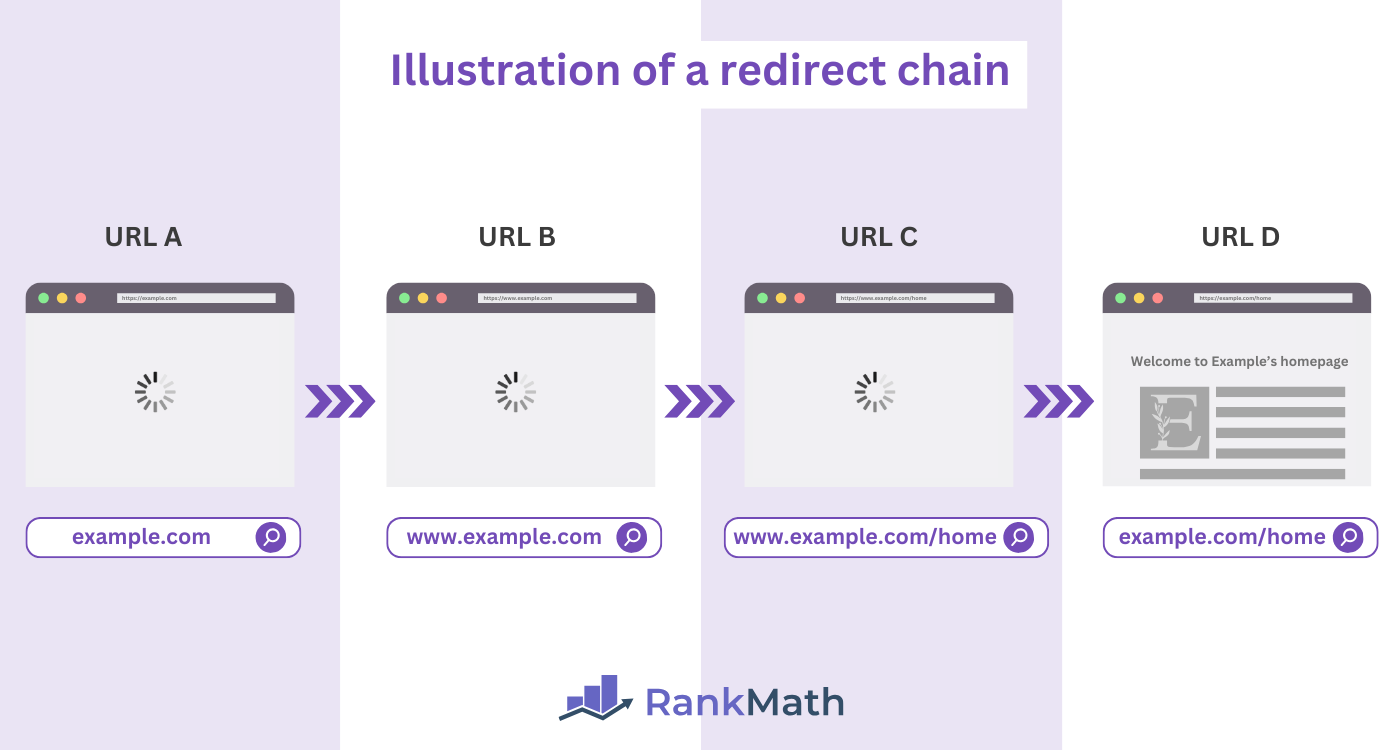What is a Redirect Chain?
A redirect chain occurs when multiple redirects are set up between the initial URL and the final URL. For example, URL A redirects to URL B, which then redirects to URL C, and finally to URL D.

A simple redirect from URL A to B and finally, to C is the most basic form of a redirect chain. However, a redirect chain can consist of more than three URLs.
While redirects are okay, redirect chains are not. They can cause multiple SEO and usability issues, including poor ユーザーエクスペリエンス and longer page load times. They can also dilute your リンクエクイティ と ページランク as your webpages lose those with each redirect.
Importance of Redirect Chains
Redirect chains are not important or helpful to SEO. If anything, they will negatively impact your SEO and user experience.
For example, Google stops following a redirect after the first five hops, after which it would treat the link like a 404お探しのページが見つかりませんでした page. This means the page would be treated as missing, which would negatively affect its visibility on 検索結果ページ.
Redirect chains can also cause additional SEO issues, including increased page load time, poor indexing, and diluted link equity and PageRank. They can also waste crawl budgets, which can limit the amount of pages search engine crawlers crawl and 索引 on your site.
Redirect Chain Best Practices
Redirect chains can negatively impact your SEO, user experience, and site performance. To mitigate these issues, it is essential to follow the best practices mentioned below.
1 Minimize the Amount of Redirects
Reduce the number of redirects in the chain. In an ideal situation, each link in the chain should point directly to the final URL. However, if you have to use a redirect, keep it to two or three hops at the maximum.
Overall, make sure to avoid unnecessary redirects. You should also update your internal links to point to the final URL rather than to a URL that redirects them to another URL.
2 Always Use Appropriate Redirects
Search engines use redirects to understand how to process your links and content. For instance, Google considers a permanent redirect a strong indicator that the final URL should be treated as canonical.
In contrast, it views a temporary redirect as a weak indicator for setting the final URL as canonical. Similarly, search engines do not pass link equity to the final URL in a temporary redirect. However, they would pass link equity to the final URL in a permanent redirect.
Ensure you use the correct redirects that best reflect your intent for the content. Use the 301 Moved Permanently for permanent redirects and 302 Found for temporary redirects. You can refer to this guide to select the appropriate redirect.
3 Do Not Disallow Redirected URLs Using the robots.txt File
Do not create robots.txt rules that disallow search engines from crawling the URLs in the chain. Such action can prevent search engines from crawling the redirect chains, which would ultimately lead to indexing issues.
4 Avoid Redirect Loops
Redirect chains can lead to redirect loops. A redirect loop occurs when the final URL in a chain points back to the initial URL. This creates an infinite cycle that prevents the browser from loading the page. Reducing your redirect chains minimizes the risk of encountering redirect loops.
5 Avoid Mixing HTTP and HTTPS in Redirects
Randomly switching between HTTP と 翻訳 will complicate your redirects, create unnecessary complexity, and trigger security warnings. To avoid this, ensure all redirects use HTTPS. This maintains a secure connection and prevents confusion for visitors and search engines.
6 Test Your Redirects
After setting up redirects, test them to ensure they function as intended and direct users to the correct destination. This helps prevent errors, including incorrect and unintended redirections.